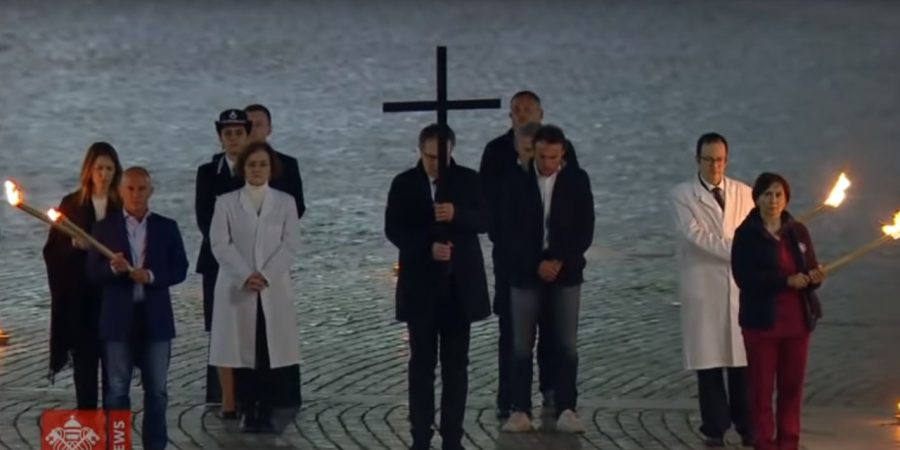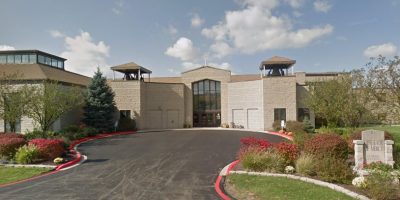In Rome, the Via Crucis procession usually takes place late in the evening on Good Friday in the shadow of the Colosseum.
Pope Francis shines a light on prisoners during Good Friday’s unusual Via Crucis

In Rome, the Via Crucis procession usually takes place late in the evening on Good Friday in the shadow of the Colosseum. Crowds of faithful would gather under the historic monument to meditate along with the pope and reflect on the stages that led to the crucifixion of Jesus.
But this year the procession took place in St. Peter’s Square and without the presence of the faithful. Only a few, including Pope Francis, were present as lights placed at several stations of the large square guided their steps.
RELATED: As a pandemic peaks at Christianity’s Easter climax, churches adapt online
While many aspects of the evening had changed, some remained the same. Every year the pope asks individuals to offer meditations reflecting on the various stations of the cross. In the past, he has used this to shine a light on some of the topics he holds most dear, from the needs of young people to the plight of human trafficking.
This year, Pope Francis asked fourteen people from the “Due Palazzi” prison in the northern Italian city of Padua to write their meditations. This comes as strong coronavirus measures in Italian prisons have led to riots and even some deaths, as prisoners pushed back against the restrictions.
Dozens of prison riots started early in March after the government prohibited visits and day releases to halt the spread of the pandemic. Many prisoners said they were not receiving adequate treatment and safeguarding measures.
As pictures of Italian prisoners wearing DIY facemasks on the roof of detention facilities circulated online, Pope Francis appealed to citizens and governments on their behalf.
The pope has mentioned “the suffering prisoners” more than three times during his morning Mass at Domus Sancta Marta, where he lives, and, on April 5, he pleaded for governments to find solutions for overcrowded prisons so “that this pandemic (does not end) in a great calamity.”
RELATED: Click here for complete coverage of COVID-19 on RNS
This year’s Via Crucis is the latest occasion during which Pope Francis chose to highlight the suffering of prisoners, their loved ones and caretakers.
Each prisoner’s meditation during the Good Friday observation drew from the life experiences of the author, in light of a specific event of the Passion of Christ. At the third station of the cross, one prisoner reflected on the first time Jesus falls, drawing a parallel with the first time he sinned.
“My first fall was failing to realize that goodness exists in this world. My second, the murder, was really its consequence, for I was already dead inside,” he wrote.
Ten people led the procession carrying the cross, five from the prison and five from the Health and Hygiene department at the Vatican. They followed the lights through the stations and meditations, each inspired by moments of great pain and redemption within the prison facilities.
One prisoner, condemned to a life sentence along with his father, identified with Barabbas, the criminal who in the Gospel is freed in Jesus’ stead.
“The harshest condemnation remains that of my own conscience,” he wrote. “At night I open my eyes and I desperately search for a light that will shine upon my story.”
Another hoped to become like Simon of Cyrene, the man who helps Jesus hold the weight of the cross, after experiencing the kindness of another inmate himself.
“I’m growing old in prison: I dream that one day, I will be able to trust others. To become a Cyrenean, bringing joy to someone,” he wrote.
One inmate, who claimed to “have fallen all too many times,” reflected on a life separate from his family, unable to see the birth of his granddaughter.
“In prison, the worst form of despair is to think that life no longer has meaning. It is the greatest suffering: of all the lonely people in the world, you feel like the loneliest,” he wrote.
By contrast, Pope Francis also invited people who have been affected by a crime to offer meditations. The parents of a daughter who was murdered wrote that “time has not erased the weight of the cross placed upon our shoulders.”
The mother of a prisoner described how she turns to the Virgin Mary who helps her “not to give into despair and to cope with the pain.”
A priest — who, after years in prison for allegedly committing sexual abuse, was found innocent — offered his meditation on Jesus being nailed to the cross.
“I hung on the cross for ten years,” he wrote. “My Way of the Cross was populated with dossiers, suspicions, accusations, insults. Each time I was in the courtroom, I looked for the crucifix: I kept my eyes fixed on it as the law investigated my story.”
The biggest survivor network in Italy, Rete L’Abuso, objected to the announcement that the exonerated priest was being invited to offer the meditation. In a post on their website April 7, they stated that his inclusion would undermine the many true claims of sexual abuse by clergy.
RELATED: Cardinal Pell is freed after Australian High Court finds fault in sexual abuse charges
The Via Crucis also included the meditations of a corrections officer, a magistrate, a volunteer, a catechist and a prison teacher who have dedicated their lives to helping and supporting prisoners.
The “Due Palazzi” Prison holds more than 600 people, 300 police officers and about 100 employees. Since 2011, Father Marco Pozza has worked there and has enlisted the help of about 80 volunteers to evangelize and administer to the inmates.
Prisoners from this facility visited with Pope Francis in 2016, when the pope inaugurated the Jubilee of prisoners for the Extraordinary Holy Year of Mercy that allowed them to receive indulgence for their sins.
Francis’ concern for inmates became evident early on in his pontificate. In March 2013, shortly after his election, Francis celebrated Holy Thursday at a juvenile detention facility in Rome. There, he washed the feet of the inmates.
“Don’t be overcome by sadness,” the pope told them in an off-the-cuff remark on the occasion.
“You must think about interior renewal and hope to begin again. … Every penalty must be open to the horizon of hope, that’s why the death penalty is neither human nor Christian.”
Read more news at XPian News… https://xpian.news



Comments are Closed